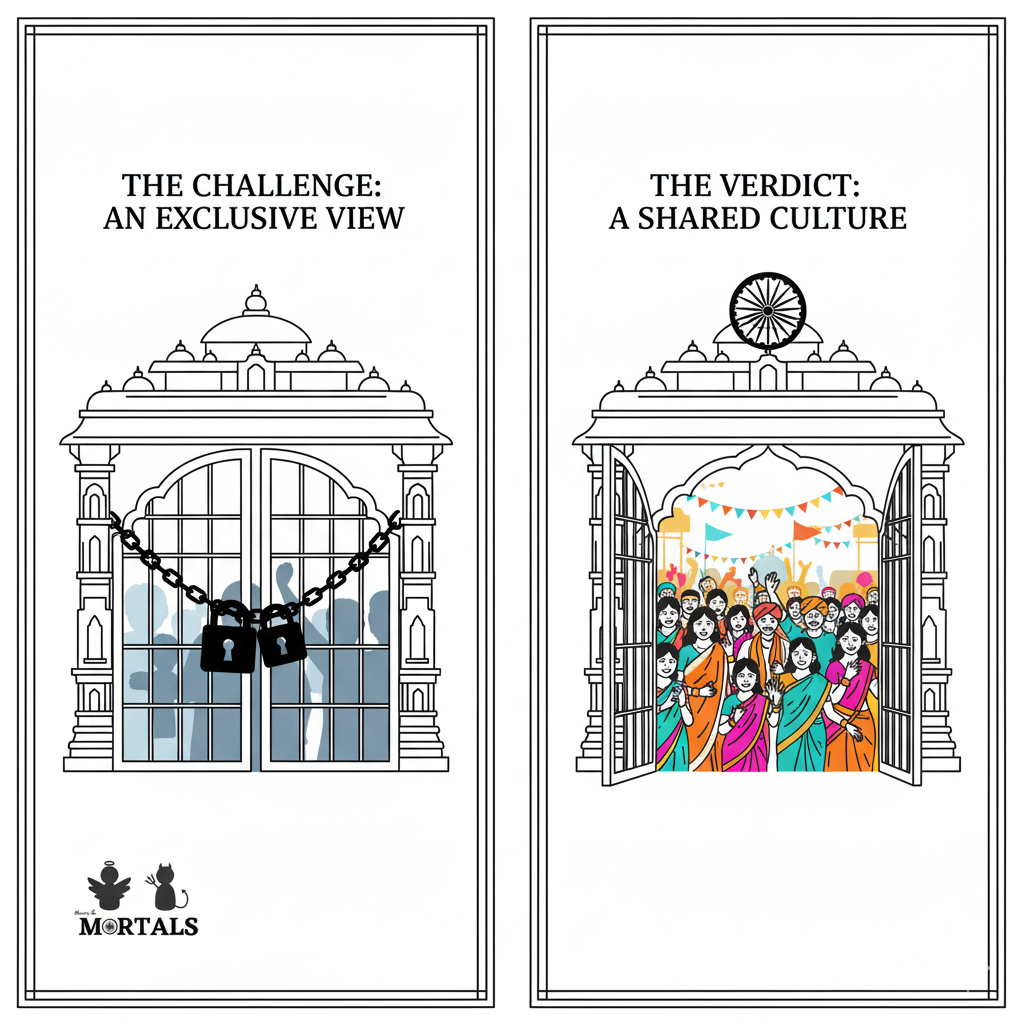The world-famous Mysuru Dasara is a spectacle of light, sound, and tradition, a celebration that has long been a symbol of Karnataka’s vibrant culture. This year, however, it became the stage for a national debate. When the state government invited a celebrated author, who happens to be Muslim, to inaugurate the festivities, a petition was filed in the Supreme Court to stop her. The court’s decisive ruling was not just about one festival or one author; it was a powerful reaffirmation of the “basic structure” of the Indian nation and a defense of the shared, pluralistic culture that lies at its very heart.
The Information Box
Syllabus Connection:
- Paper 2: Chapter 4 (Religion and Society in India: Communalism, Secularism), Chapter 1.1 (Indian Civilization)
- Paper 1: Chapter 5 (Anthropology of Religion), Chapter 4 (Political Anthropology: State & Secularism), Chapter 4.3 (Legal Anthropology)
Key Concepts/Tags:
- Secularism, Basic Structure, Syncretic Culture, Public vs. Private Sphere, Communalism, Supreme Court
The Setting: Who, What, Where?
The setting is the iconic Mysuru Dasara festival in Karnataka, an event with deep religious roots that has evolved into a major state-sponsored cultural celebration. The central action was the Karnataka government’s invitation to International Booker Prize-winning Kannada writer Banu Mushtaq to inaugurate the festival. This decision was challenged via a petition in the Supreme Court, which alleged that the participation of a non-Hindu in an event starting at the Chamundeshwari Temple violated the constitutional right to freedom of religion.
The Core Argument: Why This Study Matters
This case study is a crucial lesson in the judicial defense of Indian secularism and pluralism.
- Reaffirming “Secularism” as the Basic Structure: The most significant outcome is the Supreme Court’s forceful restatement that secularism is a fundamental and non-negotiable part of the Constitution’s “basic structure.” The fact that the court felt the need to reiterate this foundational principle highlights the contemporary pressures being exerted on it.
- The Critical Distinction: “State Event” vs. “Religious Ceremony”: The court’s entire judgment hinged on a key anthropological and legal distinction. It clarified that the Mysuru Dasara, as sponsored and organized by the government, is a “State event”—a public, cultural festival—and not a private, exclusionary religious ceremony. This classification is critical because it means the state, as a secular entity, cannot discriminate on the basis of religion in the public sphere.
- Defining Religious Freedom as Inclusive: The verdict provided an important interpretation of Articles 25 and 26. The court ruled that the constitutional right to practice one’s own religion does not grant a right to exclude others from public cultural festivities. It reframes religious freedom not as a right to create exclusive ghettos, but as a right that coexists with the public’s right to inclusive celebration.
The Anthropologist’s Gaze: A Critical Perspective
- Syncretic Culture Under Attack: An anthropologist would immediately identify this conflict as a modern attack on India’s long and rich history of syncretic culture. For centuries, festivals, shrines, and pilgrimages have been spaces of shared participation across religious lines. The petition represents a politicized, contemporary attempt to “purify” these traditionally shared spaces and draw hard, impermeable boundaries between communities where they were once fluid.
- The Battle to Define the “Public” Sphere: The court’s distinction between a “State event” (public) and a “private religious ceremony” is a key anthropological concept. This case study is a battle over the power to define that boundary. The petitioners sought to shrink the public sphere by defining the inauguration as a “private” Hindu affair, while the state and the court defended its status as a “public” cultural event open to all citizens.
- The “Invention of Offence”: The editorial’s point about “political opportunists” creating rifts is what an anthropologist might call the “invention of offence.” The participation of a celebrated Kannada author was turned into a “problem” not by the general populace, but by a motivated group seeking to create a communal rift for political gain. This shows how communal tensions are often actively manufactured rather than being a natural outcome of diversity.
The Exam Angle: How to Use This in Your Mains Answer
- Types of Questions Where It Can be Used:
- “Secularism is a part of the ‘basic structure’ of the Indian Constitution. Analyze the challenges it faces.”
- “Discuss the nature of syncretic culture in India and the forces threatening it.”
- GS-2: “Analyze the role of the Supreme Court as the guardian of the Constitution.”
- Model Integration:
- On Secularism (GS-2/Anthro): “The strength of Indian secularism is periodically upheld by the judiciary. In the recent Mysuru Dasara controversy, the Supreme Court reaffirmed that secularism is part of the ‘basic structure’ and clarified that the state cannot discriminate on religious grounds in public cultural events, distinguishing them from private religious ceremonies.”
- On Syncretic Culture (GS-1/Anthro): “India’s traditional syncretic culture, where communities have long participated in each other’s festivals, is facing challenges from modern communal politics. The recent petition against a Muslim author inaugurating the Mysuru Dasara, and its firm rejection by the Supreme Court, highlights the ongoing struggle between India’s history of coexistence and contemporary forces seeking to create religious divisions.”
- On the Judiciary’s Role (GS-2): “The Supreme Court often acts as a guardian of constitutional morality. Its ruling in the Mysuru Dasara case, protecting the state’s inclusive decision, is a powerful example of the judiciary defending the principles of pluralism and secularism enshrined in the Constitution’s Preamble against sectarian challenges.”
Observer’s Take
The Mysuru Dasara controversy is a microcosm of a larger battle for the soul of India. On one side stands a long and beautiful history of a shared, syncretic culture, where festivals have served as bridges between communities. On the other stands a modern, cynical politics that seeks to dynamite these bridges and build walls in their place. The Supreme Court’s verdict is more than just a legal ruling; it’s a powerful defense of that shared heritage. It serves as a crucial reminder that the constitutional promise of secularism is not a passive tolerance of our differences, but an active, joyous celebration of them in the public square.





